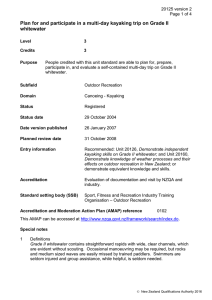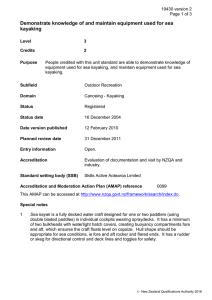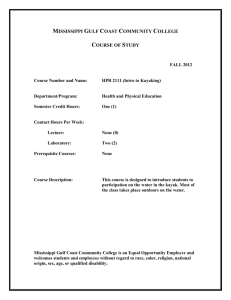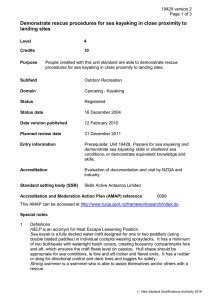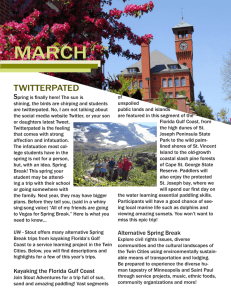Complete a one-day and a multi-day sea kayaking trip with... close proximity to landing sites
advertisement
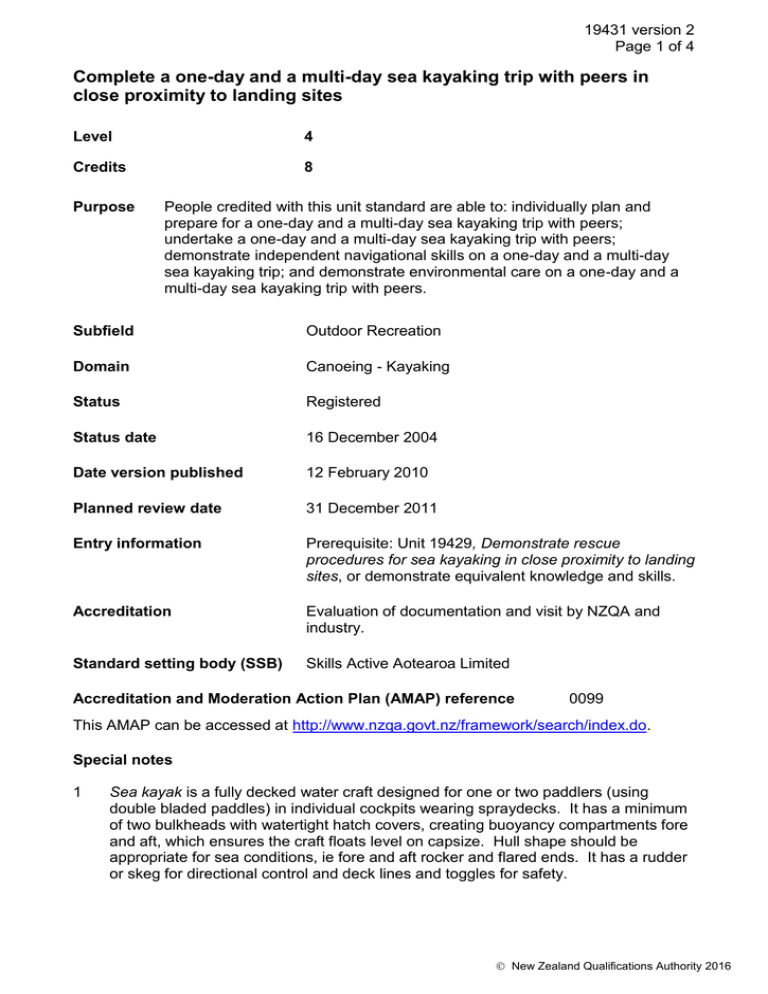
19431 version 2 Page 1 of 4 Complete a one-day and a multi-day sea kayaking trip with peers in close proximity to landing sites Level 4 Credits 8 Purpose People credited with this unit standard are able to: individually plan and prepare for a one-day and a multi-day sea kayaking trip with peers; undertake a one-day and a multi-day sea kayaking trip with peers; demonstrate independent navigational skills on a one-day and a multi-day sea kayaking trip; and demonstrate environmental care on a one-day and a multi-day sea kayaking trip with peers. Subfield Outdoor Recreation Domain Canoeing - Kayaking Status Registered Status date 16 December 2004 Date version published 12 February 2010 Planned review date 31 December 2011 Entry information Prerequisite: Unit 19429, Demonstrate rescue procedures for sea kayaking in close proximity to landing sites, or demonstrate equivalent knowledge and skills. Accreditation Evaluation of documentation and visit by NZQA and industry. Standard setting body (SSB) Skills Active Aotearoa Limited Accreditation and Moderation Action Plan (AMAP) reference 0099 This AMAP can be accessed at http://www.nzqa.govt.nz/framework/search/index.do. Special notes 1 Sea kayak is a fully decked water craft designed for one or two paddlers (using double bladed paddles) in individual cockpits wearing spraydecks. It has a minimum of two bulkheads with watertight hatch covers, creating buoyancy compartments fore and aft, which ensures the craft floats level on capsize. Hull shape should be appropriate for sea conditions, ie fore and aft rocker and flared ends. It has a rudder or skeg for directional control and deck lines and toggles for safety. New Zealand Qualifications Authority 2016 19431 version 2 Page 2 of 4 2 All activities must comply with any relevant environmental, legislative and/or regulatory requirements set out in the New Zealand Environmental Care Code; New Zealand Water Care Code; Health and Safety in Employment Act 1992; Injury Prevention, Rehabilitation, and Compensation Act 2001; the Sea Kayak Operators Association of New Zealand (SKOANZ), Code of Practice, May 1999 available at http://www.skoanz.org.nz/seakayak/code.html; and their subsequent amendments. The New Zealand Environmental Care Code, and New Zealand Water Care Code are available from the Department of Conservation, Head Office, PO Box 10420, Wellington 6143 or http://www.doc.govt.nz/parks-and-recreation/plan-andprepare/care-codes. 3 Assessment against this unit standard should be carried out under the following conditions: within two kilometres of safe landing sites, with 30 minutes paddling from safe landing sites. Environmental conditions should not exceed: for open water – winds up to 20 knots, surf up to one metre, waves or swell up to 1.5 metres, current up to four knots, water temperature above seven degrees Celsius, air temperature above seven degrees Celsius. 4 In the context of this unit standard a multi-day sea kayaking trip refers to a trip of two to four days and includes at least one night. Elements and performance criteria Element 1 Individually plan and prepare for a one-day and a multi-day sea kayaking trip with peers. Performance criteria 1.1 Clothing and equipment are selected according to trip requirements and their selection justified. Range 1.2 Each trip is planned according to the trip and local marine requirements. Range 1.3 safety, personal and kayaking and repair equipment. route, weather, access and exit, transport, leadership, escape options, contingencies, tides; needs and characteristics of group members include but are not limited to – ability, experiences, cultural, special needs, language, confidence, medical conditions, physical and mental state. The sea kayak is packed with equipment in accordance with the expected sea and weather conditions to maintain all packed equipment in dry condition. Range single day, multi-day, overnight equipment. New Zealand Qualifications Authority 2016 19431 version 2 Page 3 of 4 Element 2 Undertake a one-day and a multi-day sea kayaking trip with peers. Performance criteria 2.1 The sea kayak is landed and launched with the sea kayak stable, and control is maintained at all times. Range must include surf conditions. 2.2 Efficient and effective paddling strokes and fitness for extended periods (eg up to 40 km per day) are demonstrated for extended periods when packed for multi-day trip. 2.3 The dynamics of surf and wave formations are described and the knowledge is applied to the sea kayaking trips to ensure safety of self and peers. 2.4 The effects of tide, current, wind, and local conditions are considered during the sea kayaking trips to ensure the safety of self and peers. 2.5 Adverse weather signs are recognised, and appropriate decisions are made and justified in accordance with safety considerations. 2.6 Environmental hazards are identified in terms of their possible effect on kayaks, and methods for avoiding and/or managing them are demonstrated. Range rock, rips, marine life, storms, wind, waves, extreme temperature. 2.7 Appropriate decisions are made, including contributions to group decision making, regarding trip commencement and completion in terms of safety for self and peers. 2.8 Changes to initial trip planning allow for strengths and weaknesses of others in the group and mutual support is demonstrated. Element 3 Demonstrate independent navigational skills on a one-day and a multi-day sea kayaking trip. Performance criteria 3.1 Times and distances for the legs of the planned sea kayaking trips are calculated. 3.2 Navigational fixes are taken from known landmarks on and off the water. Range 3.3 map, compass, electronic devices. Bearings are followed allowing for wind and sea conditions. New Zealand Qualifications Authority 2016 19431 version 2 Page 4 of 4 3.4 Location is identified and a six-figure grid reference from a topographical map is provided. Element 4 Demonstrate environmental care on a one-day and a multi-day sea kayaking trip with peers. Performance criteria 4.1 Care for the environment is undertaken in accordance with the New Zealand Environmental Care Code. Range must include campsite management. Please note Providers must be accredited by NZQA, or an inter-institutional body with delegated authority for quality assurance, before they can report credits from assessment against unit standards or deliver courses of study leading to that assessment. Industry Training Organisations must be accredited by NZQA before they can register credits from assessment against unit standards. Accredited providers and Industry Training Organisations assessing against unit standards must engage with the moderation system that applies to those standards. Accreditation requirements and an outline of the moderation system that applies to this standard are outlined in the Accreditation and Moderation Action Plan (AMAP). The AMAP also includes useful information about special requirements for organisations wishing to develop education and training programmes, such as minimum qualifications for tutors and assessors, and special resource requirements. Comments on this unit standard Please contact Skills Active Aotearoa Limited info@skillsactive.org.nz if you wish to suggest changes to the content of this unit standard. New Zealand Qualifications Authority 2016
